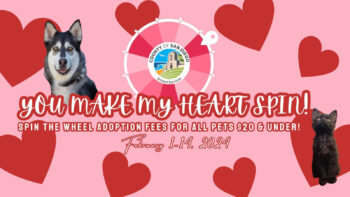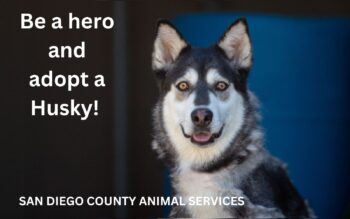If you’re strong enough to do it, when you lift 50-plus pound Mishka the dog off the ground, he goes limp and cuddly like a ragdoll.
Then there’s Jake, who scrambles and pants with excitement when he meets a stranger, but also looks into eyes awaiting a cue. When you tell him “sit” or “shake” he calms down and shows his skills.
Both dogs would make great pets for the right owners, say staff and volunteers at the County’s animal shelter in Carlsbad.
But they’re pit bulls. They’re not going to have any easy time finding someone to give them a chance.
Enter the Pit Crew, a small group of passionate volunteers who join staff and rescue groups to work with and champion pit bulls at the County Department of Animal Services in Carlsbad.
The Pit Crew trains the dogs with positive reinforcement, takes them out for walks and structured playtime with other dogs, highlights them at adoption events outside the shelter and talks to the public about responsible pet ownership and what wonderful pets the dogs can be.
“There are so many people who don’t understand they’re just like any other dog,” says Cat Intoci, a three-year shelter volunteer who joined the Pit Crew last year.
| There are so many people who don’t understand they’re just like any other dog. |
| -Cat Intoci, Pit Crew volunteer |
The Crew’s work helps the Department of Animal Services, which cares for pit bulls relinquished by their owners or picked up as strays. Pit bulls are represented disproportionately in the County’s three shelters. At any given time, it’s common for 25 to 40 percent of our kennels to hold “bully breed” dogs, says Lauren Joniaux, County Animal Services deputy director and head of its shelter in Carlsbad.
Pit bulls are not actually a breed, but a description for mixed and purebred bully breed dogs that include the American pit bull terrier, American Staffordshire terrier and Staffordshire bull terrier.
The shelter in Carlsbad serves the rural communities of Valley Center, Ramona and Fallbrook, where the highest percentage of pit bulls are often picked up as strays or relinquished to the shelter by their owners. Few owners ever attempt to claim these dogs, and many are not spayed or neutered.
Joniaux says many of these dogs appear to be “resident dogs,” which means they have had little socialization and are kept isolated in a yard or tied up with little or no human contact. These are not “family dogs” that are well loved and properlysocialized pets.
The pit bulls face long waits for adoption, so their numbers add up. But the Pit Crew tries to change their chances of finding a family.
Intoci says, like any other dog, pit bulls are individuals. Some like other animals and play nice; some don’t; some love kids; others are annoyed by them; some are goofy, some are dignified. And, like any other dogs, pit bulls are more predictable and safer when they are well-trained, well-loved, and well-understood by owners.
Tiffany Shields, the shelter’s Supervising Animal Care Attendant, and Joniaux echo that. Shields and other pit bull advocates say media coverage has shaped a common misperception that pit bulls are universally dangerous and aggressive.
Locally, a terrible and ultimately fatal mauling of a 75-year-old Paradise Valley woman by two pit bulls that got out of their yard through a broken fence has added to the public’s concerns about the breed.
But the Department of Animal Services and most animal humane groups view dog bites as “situational” rather than breed-driven. When you inspect the circumstances of a particular bite, factors unique to the case, many of which could have been avoided, have usually resulted in the bite, says Joniaux.
Those factors may include the dog being unneutered, untrained, unsupervised and not socialized with humans or other animals.
Intoci and other Pit Crew volunteers last year received instruction from a professional dog trainer and rescue groups on training techniques and dog behavior. The volunteers use what they learned to work with pit bulls at the shelter and educate the public about the dogs’ trainability and tractability.
The Pit Crew’s formation and their instruction came as part of a one-year program called Shelter Partners for Pit Bulls, which was piloted in five shelters nationwide, including San Diego County Animal Services.
Utah-based Best Friends Animal Society received a grant for the pilot program from PetSmart Charities. Although the program’s sponsorship ended in December, volunteers and staff are working to keep the Pit Crew program running.
Early on in the program, the Pit Crew realized the importance of training pit bulls to be on excellent behavior when the public wanders through the kennel area. If the dogs aren’t perfect, they won’t often get a second look.
So Pit Crew volunteers use clickers, treats and other techniques to train the dogs to stay on four feet when someone walks by.
Teri Brooks, a dedicated member of the Crew, explains how she works with pit bulls in their kennels.
“If they’re barking, I ignore them; if they jump up while I’m approaching, I’ll turn my back; when they’re back down on all fours, I click and ‘treat’ them,’” she says.
Brooks and her husband adopted their first pit bull “Chance” from Animal Services about a year ago and, in the process, learned how to socialize and train dogs.
“She was maybe 1 (years old), and she wasn’t very well socialized, she was scared of strangers, scared of kids,” Brooks said. “She couldn’t walk on a leash.”
But with the help of Brooks’ care and training, Chance has become social, confident, and well-mannered, her owner says. Chance’s transformation has convinced Brooks that most pit bulls in the shelter would thrive with the right owner.
“There are so many dogs in the shelter who need less than she did,” Brooks said.
Brooks is friendly and voluble, so when she takes shelter pit bulls out for walks around the Batiquitos Lagoon or in Carlsbad Village, she talks about the breed to the public, showing and telling people how smart, manageable and affectionate the dogs can be. She also shows off dogs at adoption fairs
Brooks said these outings and events help the public see pit bulls in a positive light. And sometimes, they lead to adoptions.
Caroline the pit bull was one of many dogs who become unhappy and anxious in the shelter. But outside, she proved to be well-adjusted and gentle with people and other dogs.
Last year, Brooks took Caroline to an adoption event at PetCo Unleashed in Carlsbad. There, a family admired her and asked Brooks many question about her personality, training and pit bulls in general.
After discussing it at home for a day, the family showed up at the Carlsbad shelter to take Caroline home.
“I was so happy for Caroline and that family,” said Brooks. “A lot of times those dogs that that do the worst in the shelter do the best outside.”
To follow the Pit Crew or see pits bulls up for adoption at the County shelter, visit the Pit Crew’s Facebook page.



